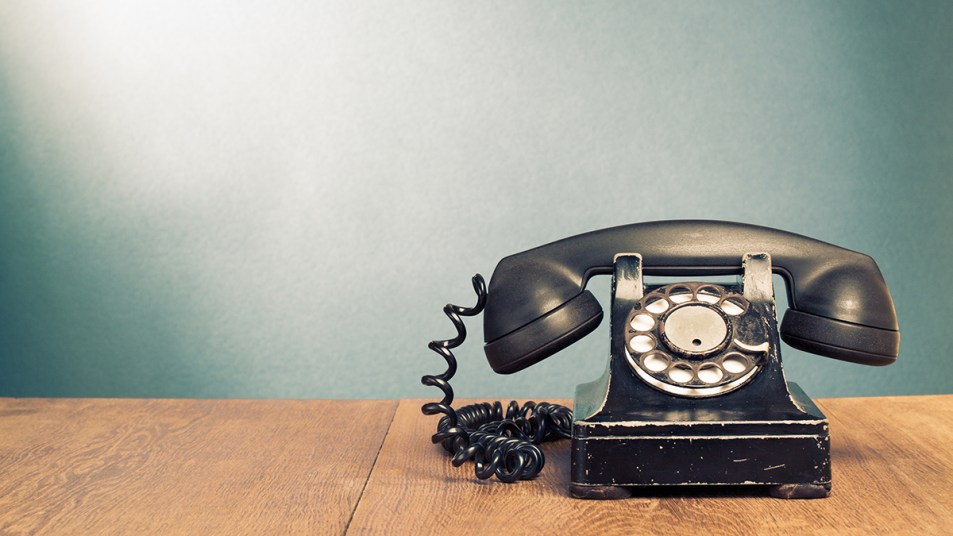Hello! That Old Phone Sitting in the Corner of Your Garage Could Be Worth up to $8,000
These often overlooked antiques can deliver quite a payday

If you’re like us, you’ve got so much old junk sitting up in your attic or tucked away in that shed in the backyard that you don’t have the foggiest idea what all is there. Well, it may be time to find out! Word on the antique-buyers’ street is that vintage telephones can pull in big bucks. Read on to see what your old phone’s value may be.
What is a vintage telephone?
The telephone has gone through more drastic changes than we can count since it was first invented by Alexander Graham Bell nearly 150 years ago. It’s because of this long history that antique phones are popular among collectors for their fascinating designs and the way they capture a long-ago era. According to The Olde Telephone Company, an Oregon-based specialist shop, there are three main types of vintage telephones, two of which are technically considered antique. These are:
- Desk Set Phones. Most phones made after 1930 fall into this category, and their shapes are familiar to anyone who grew up after this time. While desk telephones are considered vintage, rather than technically antique, they’ve become prized by collectors for their many stylistic variations and the nostalgia they instantly conjure up.
- Wood Wall Phones. The oldest type of phones, these wall telephones were handmade from wood and look more like heirloom pieces of furniture than the desk set phones you remember. True to their name, these phones were mounted on walls, and they were produced from 1876 through World War II.
- Candlestick Phones. These antique candlestick telephones, which were produced from the 1890s to the 1920s, got their name from their slim appearance. Much sleeker than wood wall phones, you may have seen these kinds of phones in old movies. Their distinctive shape features a mouthpiece on top of a long stand, and a receiver you hold to your ear.
Once you’ve identified the style of your vintage telephone, you’ll have a better sense of when it’s from (if you don’t know this already) and how valuable it may be.
What makes a vintage telephone valuable?
Not all older phones are created equal. Telephone Archive, a site dedicated to this niche of collecting, recommends you look out for the below attributes:
- Completeness. Does your phone have all of its original pieces? These are often broken or lost over time, so having a complete phone will make it more valuable.
- Condition. As is typically the case with antiques, condition is key. You’ll want your phone to lack paint chipping, issues with the wood, or other obvious flaws.
- Authenticity. There are many reproductions of vintage telephones on the market, and these are not considered valuable, so you’ll want to confirm that your phone is original.
- Does it work? Whether or not an antique phone should be restored is a subject of debate in the collecting community. Telephone Archive reports, “Some collectors will pay more for a phone which has been restored to working order; others feel that anything that has been done to the phone in as-found condition decreases its value.” Restoring an antique phone, of course, will also take additional time, money, and expertise.
It is helpful to figure out who made your antique phone. Here’s a list of the best-known antique telephone manufacturers, according to Telephone Archive:
- Western Electric. They produced the majority of phones used in the US for almost a century, and were around from 1881 to 1995.
- Automatic Electric. This company invented the first automatic dial telephone switch in 1889 and was around from 1889 to 1983.
- Kellogg Switchboard and Supply. This company, which was around from 1897 to 1951, was known for their innovations in switchboard technology.
- Stromberg Carlson. One of the largest suppliers to independent telephone companies, they were around from 1894 to the 1960s.
- Gray Telephone & Pay Station. This company created the coin payment mechanism for pay phones, and was around from 1889 to 1948.
- North Electric. Beginning as a telephone and switchboard repair company, this brand was around from the 1880s to the 1970s.
There are many more brands that made early candlestick phones, as that market was quite fragmented and competitive.
How much can antique phones sell for?
Antique phones can sell for a wide range of prices, depending on the factors listed above. The Antique Telephone Collectors Association (ATCA) can help facilitate buying, selling, and appraising phones. They also put on Telephone Collector Shows where collectors can show off their prized goods. The Olde Telephone Company can also appraise your phone.
While the ATCA doesn’t list prices of phones from the shows on their site, there’s a robust market for antique telephones on eBay. Currently, the auction site offers antique wood wall phones ranging from $85 to $825 and antique candlestick phones ranging from $12 to $8,000. There are also many small specialty antique phone shops around the web. Clearly, phone prices can run the gamut, but on average you should be able to get at least a couple hundred dollars for an antique phone in good condition, and even more if it has certain desirable features.
Ring, ring, ring!
The world of vintage telephone collecting is odd but wonderful — there are many beautiful historical phones out there, and many people who are enthusiastic about how our primary communication device has evolved throughout history. Antique telephones are art pieces and reminders of the everlasting power of conversation. Don’t have an antique phone? Check out our guides to antique perfume bottles and antique picture frames.
Read on to learn about more surprisingly valuable vintage pieces:
Could Your Antique Perfume Bottles Be Worth Thousands of Dollars? Maybe, Say Collectors
Hello! That Old Phone Sitting in the Corner of Your Garage Could Be Worth up to $8,000
Vintage Record Players Have Made a Comeback — Yours Could Be Worth $1,000s













